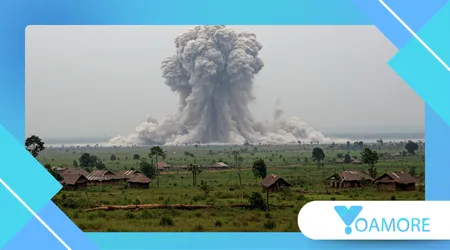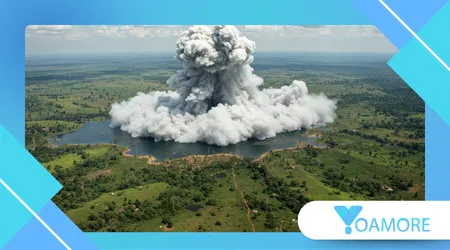A Explosão do Lago Nyos: Um Assassino Silencioso na África

Em agosto de 1986, o explosão do Lago Nyos Em Camarões, liberou silenciosamente uma força letal que matou mais de 1.700 pessoas em questão de minutos. Sem fogo. Sem estrondo.
Anúncios
Apenas uma nuvem invisível e inodora de dióxido de carbono varrendo os vales, sufocando tudo em seu caminho.
É um dos desastres naturais mais assustadores da história moderna — e, ainda assim, um dos menos lembrados.
Este artigo revisita a catástrofe sob uma perspectiva voltada para a ciência, a memória social e a resiliência. Exploramos como a tragédia ocorreu, o que a ciência aprendeu desde então e como ela moldou a prevenção de desastres globalmente.
Uma noite sem aviso
Por volta das 21h do dia 21 de agosto, os moradores dos vales abaixo do Lago Nyos se prepararam para dormir.
Anúncios
Alguns cozinhavam; outros terminavam conversas com os vizinhos. Pela manhã, quase todos os seres vivos num raio de 25 quilômetros estavam mortos.
Uma nuvem invisível e densa de CO₂ desceu do lago, agarrando-se ao chão e sufocando todos que estavam ao seu alcance.
Corpos foram encontrados em poses calmas, como se a morte tivesse chegado suavemente. O silêncio que se seguiu foi inquietante.
Sobreviventes como Joseph Nkwain descreveram ter acordado confusos, paralisados e cercados pela morte. Ele lembrou: "Perdi minha família inteira da noite para o dia. Fui um dos poucos que acordou."
+ Como os sonhos são interpretados como presságios ao redor do mundo
O que tornou o Lago Nyos explosivo?
O Lago Nyos não é um lago comum. Localizado no campo vulcânico Oku, em Camarões, ele se encontra em uma câmara magmática adormecida, porém ativa.
Ao longo de décadas, o CO₂ vazou de baixo para cima e se dissolveu nas camadas do fundo do lago, onde a água mais fria e pesada aprisiona gases sob pressão. Os cientistas chamam isso de "lago estratificado" — e é uma bomba-relógio.
Um provável gatilho para o explosão do Lago Nyos foi um deslizamento de terra ou chuva forte que interrompeu essa estratificação.
A liberação repentina de pressão permitiu que o gás explodisse violentamente. Esse evento raro, conhecido como "erupção límnica", expeliu cerca de 1,2 milhão de toneladas de CO₂, de acordo com o Serviço Geológico dos EUA.
A nuvem de gás, mais pesada que o ar, permaneceu próxima ao solo. Asfixiou pessoas, animais e vegetação de forma silenciosa e eficiente. Os sobreviventes descreveram o ar como "denso" e irrespirável.
Leia também: O Reino Esquecido de Tartessos
Quando a ciência alcançou a tragédia
As erupções límnicas eram pouco compreendidas antes de 1986. Na verdade, o fenômeno estava quase ausente da literatura geológica.
O explosão do Lago Nyos desencadeou um frenesi científico. Equipes internacionais, incluindo geólogos americanos, franceses e camaroneses, correram para investigar.
Eles confirmaram o perigo: grandes quantidades de CO₂ haviam se acumulado no lago.
A tragédia levou ao desenvolvimento de colunas de desgaseificação — tubos que sifonam e liberam gás de camadas profundas do lago lentamente, evitando outra erupção.
Hoje, o Lago Nyos está equipado com vários desses sistemas, que ainda estão operacionais.
Um importante estudo publicado em Natureza (2020) alertou que sem manutenção contínua o lago poderia voltar a ficar instável.
Além disso, as paredes naturais do lago, erodidas pelo tempo e pelas condições climáticas, também representam um risco de falha estrutural.
Tabela: Principais fatos sobre a explosão do Lago Nyos
| Categoria | Detalhe |
|---|---|
| Data do incidente | 21 de agosto de 1986 |
| Localização | Noroeste dos Camarões |
| Número de mortos | 1.746 pessoas, 3.500 cabeças de gado |
| Tipo de desastre | Erupção límnica |
| Gás liberado | Dióxido de carbono (CO₂) |
| Volume de gás | Mais de 1,2 milhões de toneladas |
| Raio de Impacto | Até 25 quilômetros |
| Status atual | Desgaseificação em andamento; área monitorada |
| Ameaças Futuras | Erosão estrutural; risco de reacumulação de gás |
O custo real da ignorância

Antes de 1986, nenhum governo tinha protocolos para erupções límnicas. Os socorristas em Camarões estavam despreparados e sobrecarregados.
As teorias iniciais variavam de guerra química a retribuição espiritual. Demorou dias até que os cientistas conseguissem explicar o que havia ocorrido.
Dois exemplos ilustram a imprevisibilidade deste desastre. Uma jovem sobreviveu porque sua casa tinha uma janela aberta que permitia a entrada de um pouco de oxigênio.
Outro sobrevivente, um motorista de caminhão que dormia em sua cabine mais distante do lago, vivia simplesmente devido à altitude. Ambos viviam, não por aviso ou planejamento, mas por acaso.
+ 5 Descobertas antigas que reescreveram a história
Esquecido, mas não irrelevante
A atenção do mundo rapidamente se desviou do explosão do Lago Nyos, mas a ameaça não desapareceu.
Na verdade, o Lago Kivu, localizado na fronteira entre Ruanda e a República Democrática do Congo, contém cerca de 300 vezes mais CO₂ e metano do que Nyos jamais conteve.
Ela ameaça quase 2 milhões de vidas caso ocorra uma erupção semelhante.
Isso motivou amplo monitoramento e esforços de desgaseificação precoce. Governos colaboraram com cientistas internacionais para instalar sistemas de ventilação, semelhantes aos do Lago Nyos.
No entanto, a instabilidade política e a escassez de financiamento persistem. Em 2025, a região permanece vulnerável.
Para uma visão geral abrangente das tecnologias de desgaseificação de lagos e zonas de risco globais, consulte este relatório detalhado do USGS.
Lições para um mundo em aquecimento
A tragédia no Lago Nyos também se relaciona com a ciência climática. O aumento das temperaturas afeta a estratificação do lago, os padrões de precipitação e a erosão.
De acordo com a Organização Meteorológica Mundial, as mudanças climáticas podem aumentar a probabilidade de saturação de gás e instabilidade em lagos de cratera.
A tecnologia de armazenamento de gás, frequentemente anunciada como uma solução climática, agora se inspira no Lago Nyos.
Engenheiros que projetam sistemas subterrâneos de captura de carbono devem planejar o gerenciamento de pressão para evitar desencadear erupções de gás — um paralelo traçado diretamente da experiência de Nyos.
Nesse contexto, Nyos não é uma relíquia. É um conto de advertência vivo.
Isso poderia acontecer em outro lugar?
Sim. Além do Lago Kivu, existem mais de 100 lagos de cratera no mundo, muitos deles submonitorados.
Regiões na Indonésia, Filipinas e partes da América do Sul abrigam lagos vulcânicos com propriedades semelhantes. A maioria não possui sistemas de desgaseificação.
Nos EUA, os lagos da Cordilheira das Cascatas são estudados periodicamente, mas o financiamento é inconsistente. Geólogos alertam que focar apenas em erupções vulcânicas conhecidas subestima o risco de eventos com origem em gás.
Se a prevenção for motivada pela memória, então o conhecimento esmaecido da explosão do Lago Nyos pode custar vidas no futuro.
Empoderando comunidades locais
Após o desastre, o governo camaronês realocou milhares de sobreviventes para áreas mais seguras.
No entanto, muitos retornaram às aldeias originais, atraídos por laços ancestrais e terras férteis. Campanhas educativas locais agora ensinam os moradores sobre os riscos do gás e como lidar com emergências.
Sensores alimentados por energia solar e sistemas de alerta por SMS foram instalados para detectar níveis de gás e sinalizar evacuações.
Essas soluções de baixa tecnologia, conduzidas pela comunidade, costumam ser mais confiáveis do que sistemas centralizados, especialmente em regiões com infraestrutura limitada.
Para saber mais sobre os esforços atuais de mitigação de riscos, consulte este atualização do Programa de Assistência a Desastres Vulcânicos.
A memória que não podemos perder
Hoje, o Lago Nyos está calmo. Pássaros cantam. Gado pasta. À vista, é sereno. Mas, por baixo, esconde-se um conto de advertência escrito na linguagem da química, da geologia e do silêncio.
O mundo aprendeu uma lição vital: nem todos os desastres vêm com fumaça ou chamas. Alguns sussurram. E se não ouvirmos, eles gritam.
O explosão do Lago Nyos serve como um lembrete assustador de como a ignorância, a inação e a má comunicação de riscos podem amplificar uma tragédia.
Mas também demonstra resiliência: na ciência, na política e, mais importante, nas pessoas que viveram isso.
Perguntas frequentes
O que causou a explosão do Lago Nyos?
O acúmulo de dióxido de carbono (CO₂) nas profundezas do lago, liberado repentinamente devido a um gatilho natural, como um deslizamento de terra.
Ainda há risco de outra erupção?
Sim. Embora os sistemas de desgaseificação estejam ativos, o risco permanece caso esses sistemas falhem ou não sejam mantidos.
Existem outros lagos ao redor do mundo em risco?
Sim. Lagos como o Kivu, na África Central, representam ameaças ainda maiores devido ao seu tamanho e à população ao redor.
Como esse evento influencia a ciência moderna?
Ele redefiniu nossa compreensão sobre saturação de gás em lagos, riscos de armazenamento subterrâneo e prevenção de desastres naturais.
Onde posso encontrar informações mais confiáveis sobre esse tipo de desastre?
Nos sites do USGS e do VDAP, ambos especializados em riscos geológicos e vulcânicos.
